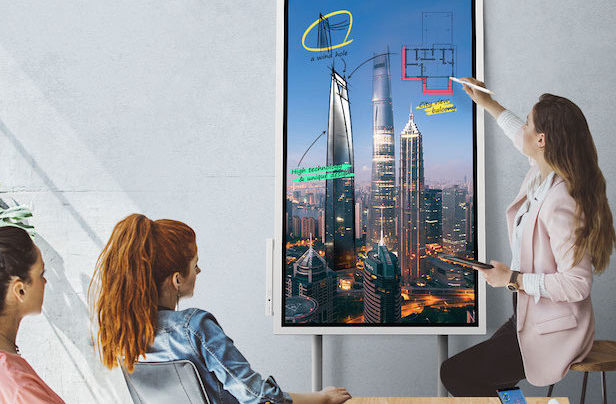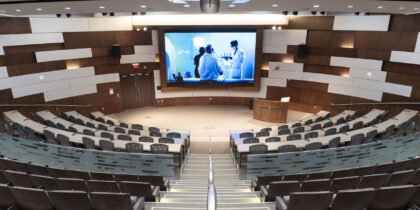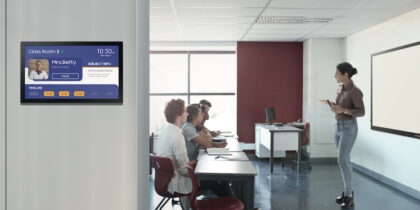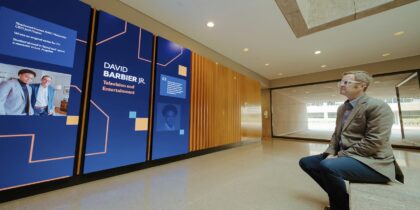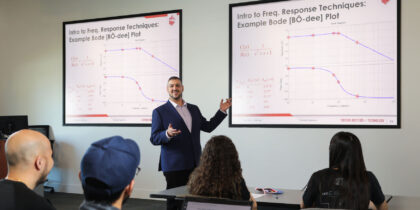A new kind of digital whiteboard may be the stuff of dreams for busy IT support teams who work in higher education — and for end-users who finally have something they can just walk up and use, without training or help.
For educators who embrace the concept of active learning — engaging and collaborating with students, instead of just instructing them in lecture settings — the new Samsung Flip is a uniquely modern spin on the age-old paper flip chart that’s still found in countless classrooms and meeting areas. Shaped like an easel-based flip chart, the Flip is a portable interactive display that allows for easy, instant collaboration.
The Flip’s simplicity and portability will be welcomed by IT support teams working in higher education, who face particular on-the-job challenges daily because:
- Technology is often spread out across many floors, buildings and campuses that cover many acres.
- Educators and students, when they need help, need it immediately.
- Most interactive technologies require initial and refresher training to encourage usage, which often falls on IT support.
- The more complicated the technology, the more prone it is to break or lock up — or need parts replacement because a critical connector, dongle or stylus has gone missing.
The Flip, by comparison, has a presence sensor that turns on the display when someone walks within range, or when someone pulls the stylus from its built-in sleeve. Unlike many touch displays, it will work regardless of a dedicated stylus — any writing tool will work and you can open menus and adjust settings with your finger. In fact, the core design principle behind Flip was that it needed to be so intuitive that no user training would be required.
Easy and Inherently Familiar
For educators, this kind of interactive technology, along with solutions geared to huddle spaces, directly addresses a marketplace need for easy, informal and inherently familiar tools for group collaboration. One of Flip’s core attributes is the ability to easily wheel the device around a building, going to where a group is gathered, instead of forcing meetings into rooms with fixed technology — rooms that are often booked and unavailable.
As many as four people can work at once on a Flip display. Users can select markup colors and the thickness of their writing or sketches, and wipe out or correct things by erasing with their hands — without getting ink all over them, because it’s all digital. Writing is very life-like, feeling and looking like a pen on paper.
The Ultimate Guide to Conference Room Technology
Download this guide to effectively plan your next meeting room technology upgrade. Download Now
Users can connect their computers to the Flip via standard HDMI, or wirelessly screen mirror content and files from mobile devices like smartphones and tablets. It’s easy to push content like images and videos to the Flip for sharing, illustrating concepts and enhancing discussions. That means in an active discussion, a student can look up a web page or YouTube video that shows exactly what they’re talking about, and get it on the screen for all to see.
Typically, with a conventional flip chart or whiteboard collaboration sessions, someone at the meeting’s end takes a photo of the notes and ideas, so the board can be erased. Or they tear off all the flip chart pages and someone transcribes the notes into a file to store and distribute. With Flip, any work can be captured and digitally stored. As many as 20 pages of content can be contained in a single note, and sorted by scrolling or using built-in search. Notes can be shared by sending emails directly from the Flip, saving to the network, downloading to a USB or simply printing them.
Huddle Up and Collaborate
Huddle spaces for informal, often impromptu meetings are increasingly common in workplace environments, but they also suit college environments. Higher ed institutions are creating huddle spaces throughout campuses: in labs, libraries, classrooms, common spaces and even dorms. They fit wherever students want and need to work together on projects, study, share insights or generate new ideas and plans.
Huddles spaces are particularly valuable when they allow distance-based collaboration, using high-speed connections, wide-angle internet cameras and audio to work with students, instructors or third-party experts located across the campus or across the planet.
Imagine a study team, working on wave energy research in Maine, getting an email and then jumping into a huddle space to talk it through with the senders, based at an Irish research institute.
As with Flip, a new generation of technology is making this kind of collaboration fast and simple. Samsung and HARMAN have collaborated to create a set of huddle space solutions designed to enable easy, productive video conferences. The company’s huddle room solutions have four configurations, from basic video conferencing all the way up to enterprise solutions with ultra high-definition displays, wide-angle HD cameras, touch overlays and smart devices for content sharing.
The Huddle Standard is a streamlined option well-suited to academic environments, with a wide-angle view camera and 1080p display, while the Huddle Premium — a notch up — has UHD displays and an AMX Acendo Vibe conferencing soundbar featuring BYOD-friendly Bluetooth and USB connectivity. Both allow remote participation.
Costs for the Flip and these bundled meeting solutions are budget-friendly, allowing universities and colleges to deploy numerous units, and grow that count as usage rates also grow. The good news for IT decision-makers looking for problem-solving tech? All these solutions are designed to require minimal intervention and support from already busy IT team members around campuses — so workflow goes as smoothly for IT as it does for students.
Learn how Samsung Flip can drive student collaboration and support campus IT departments.
